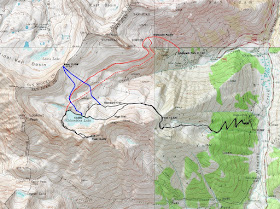Travel: From Durango, drive north on US 550 about 47 miles to Silverton. Continue north on the San Juan Skyway 7.5 miles to the "Chattanooga Curve", the right-turning hairpin at the southern base of Red Mountain Pass. At the bend's apex, turn left and drive up the 4WD, historic mining road about 1 mile and park in the pull-out at 11,160'. Starting from US 550 adds 2 miles roundtrip and 700 feet of gain.
Distance and Elevation Gain: 7 miles, 2,500 feet of climbing
Time: 5:30 to 7:00
Difficulty: Off-trail; navigation considerable; mild exposure on Peak 13,300' summit block
Maps: Silverton, Ironton, Telluride, Ophir, Colo. 7.5 Quads
Date Hiked: September 18, 2010
Quote: As we readily follow an agreeable object that flies from us, so we love to contemplate blue, not because it advances to us, but because it draws us after it. Goethe, Theory of Colors.
Columbine Lake on a crystalline autumn day.
Note to Hikers: There are three routes to Columbine Lake. What follows is a description of the Slidepath Route. I highly recommend it for the navigation savvy. If you wish to take a trail all the way to the lake, please see my post, Columbine Lake Via Standard Trail. The trail begins off the Ophir Pass Road, ascends 2,550 feet to the lake and is 6.6 miles roundtrip. Another option is a cross-country route from Porphyry Basin.
Map: The Slidepath Route to Columbine Lake is the Red-Line Route. The broken red line is an option for the return. Upon reaching the lake, join the standard Black-Line Route to climb Peak 13,300'.
Slidepath Route: The first half mile is the hardest. From the parking pull-out, walk north a few paces to a branch of Mill Creek and ascend about 100 feet. Then, turn left/west into the largest avalanche slidepath in North America. Climb 1,200 feet up the very steep, grassy pitch. Abruptly, the terrain levels considerably. This image was shot near the top of the climb in August, 2017.
Turn left/south as these hikers have done. Point 13,228', the blunt end of a southeast trending ridge, is shown.
Landforms will guide your ambling way across tundra punctured by volcanic boulders. Contour two miles to the southwest staying between 12,600 and 12,800 feet. Approaching the lake, Pt. 13,614' (below, right) and Lookout Peak, 13,661 feet (left of center) frame the route. (THW, photo)
Colors are the deeds and sufferings of light. Goethe
In 1810, Goethe wrote that absolute knowledge was not vital for joy or even contentment. The highest goal that man can achieve is amazement. For most, spending the day at the lake is astonishing enough. However, your worldview will be altered indelibly if you just walk two miles roundtrip further and climb 650 additional feet to Peak 13,300'. It is simply done. Looking at the image below, the route starts on a low bench on the right/west side of the lake and curves up the grassy/scree slope to a thin saddle at 13,100 feet.
These hikers are closing in on the saddle. (THW, photo)
From the saddle, climb 120 feet up a scrabbly west-facing ridge. Continue east to the base of the summit block, shown.
There are three routes to the crest, climber's choice. The east approach is Class 2+ with some exposure and loose rock, typical of San Juan volcanics, image-right. The west wall is a more protected Class 3 scramble, image-left. Or, scale the challenging Class 3 center crack.
From the summit look through a cobalt window into another world. (THW, photo)
Allow your eye to travel along the west ridge to the highpoint, Lookout Peak. The image below was taken from Lookout shooting back at Peak 13,300', shown directly above the climber. The lake is a muted azure on a snowy day in October. Stay with this image and look at the gentle extension to the right/south of Peak 13,300'. Be sure to walk to the end of this tabletop before returning to the lake.
Those feeling playful can descend on the beguiling rib of stone that swirls from Peak 13,300' down to the lake. Lookout Peak is just left of image-center at skyline.
Color is the first principle of Place. Ellen Meloy
If we are to hunger, let it be a hunger of the senses, not material desire. Let it be a surrender to the instinctive pull of remoteness and the intimacy of beauty. Ellen Meloy
When you can, or must, tear yourself away from turquoise waters, return the way you came.

























